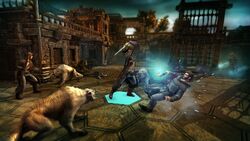RPG Codex Review: Blackguards
RPG Codex Review: Blackguards
Codex Review - posted by Crooked Bee on Fri 28 February 2014, 23:39:56
Tags: Blackguards; Daedalic EntertainmentDaedalic Entertainment's Blackguards took us by surprise. Who would have expected a German adventure game studio to make a great tactical RPG, of all things? And yet, as you may recall, our early preview of the game was, nitpicking aside, positively glowing.
It's taken us long enough since that preview and the game's official release in January, but we are now ready to present our final verdict on Daedalic's RPG debut, penned again by Darth Roxor and felipepepe. Has their opinion of the game changed since the preview? Read on to find out.
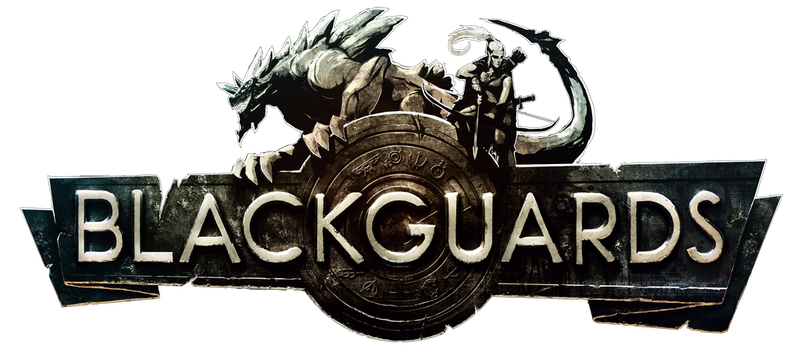
[Written by Darth Roxor, with additional commentary by Felipepepe. Edited by Infinitron.]
Blackguards – kicking ass and taking names
When Blackguards was first announced back in 2013, I largely ignored it because it had all the trappings of potential shovelware – Unity engine, a company that had never made RPGs, and shady promises of turn-based combat. However, it was still a game from Daedalic Entertainment, a German developer known for their good to brilliant adventure games (Chains of Satinav and Memoria, among others), so it was at least possible that the game would come with a very good narrative and puzzle-solving aspect.
Out of sheer curiosity, I applied for the game's closed beta, and hot damn, was that a completely mind-changing experience. Felipepepe and I described our very positive impressions of the game in our preview after it was released on Steam Early Access. But in the beta days, I only finished two out of five chapters the game had promised me, and I was very curious whether it would be consistent to the end.
And the answer is: oh hell yes it would.
Agents of Black
Before you start the game, you get to create your very own scum of the earth. Blackguards is a party-based game, with up to five characters present in your party, but you only create the main character, and all the others join up over the course of the story. The character creation can be done in two ways: either by selecting one of three pre-set backgrounds (warrior, hunter, mage) with no customization other than purely cosmetic gender, name and portrait, or by creating a character from scratch.
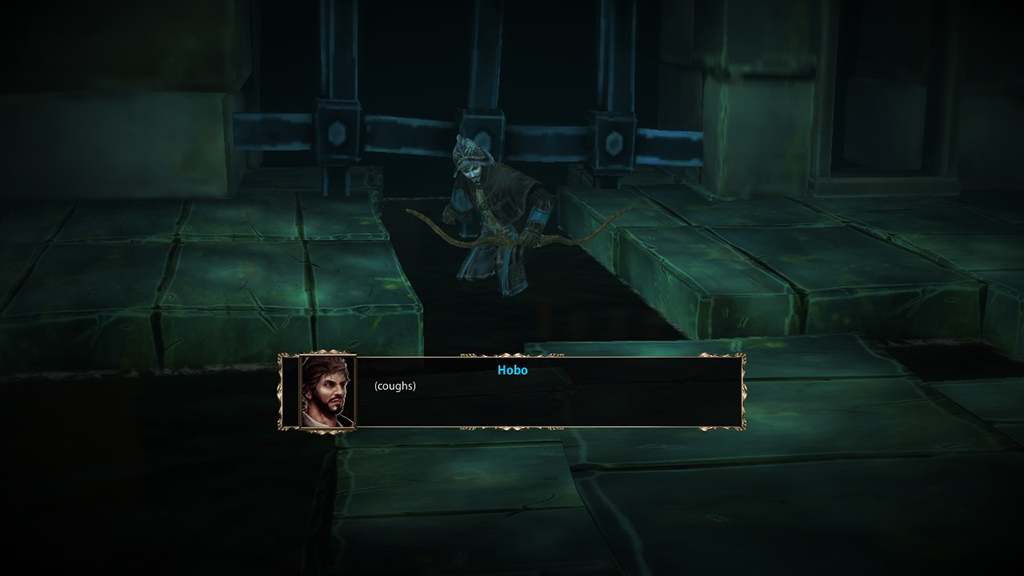
When manually creating a character, you are given 10,000 adventure points (the game’s equivalent of experience) to spend around as you like, although with some limits applied to maximum levels and available talents and spells. The ruleset is based on a later edition of Das Schwarze Auge, a pen and paper roleplaying system that is very popular in Germany, and a lot of its complexities are carried into the game, apparently without too many concessions for the computer gaming platform. This means you will likely feel overwhelmed by the sheer number of categories in which you can drop your skill points, and your inner munchkin will squeal with glee when analysing how the various statistics, spells and talents interplay. Needless to say, because of this it is also incredibly easy to completely screw up at character creation if you are doing it for the first time, and it doesn't help that you don’t have access to Blackguards' in-game rule guide at this stage either. The PDF manual is also fairly useless when it comes to explaining the rules, so you have to rely solely on the tooltips, which don’t explain all of the secrets of the system. The insane amount of stuff that you can customize leaves a lot of room for specialising and min-maxing, and it’s pretty satisfying to see your character grow in power, especially considering that some builds take considerably more time to “perfect”.
The character system has five categories of statistics – base values, weapon talents, talents, spells and special abilities.
Base values are your typical Strengths, Agilities, Charismas, etc. These are the most costly to raise, but they also have the greatest effect on your character build. For example, raising Agility will improve your attack, dodge, parry, initiative and speed rates. Some of the base values also have additional effects, such as supporting spellcasting or increasing a character’s resistance to wounds, and none of them can really be considered “dump stats” in the general scheme of things. Sure, some classes won’t find any use for a few of the stats (for example, a warrior will never need Charisma) but there’s no stat that nobody needs. Except Astral Energy (mana) and Vitality (health), I guess, because while fairly cheap, getting them through other stats is a much better investment. Next to Astral Energy and Vitality, you can also find Magic Resistance, which looks fairly uninteresting at first glance, but let me tell you here that you are going to have a very bad time if you don’t start putting points into it around the middle of the game.
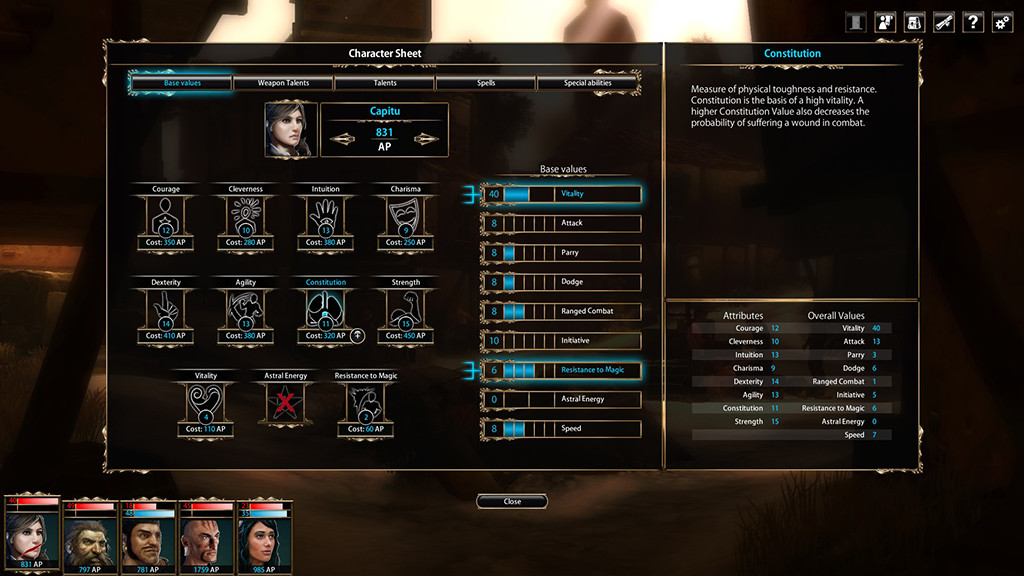
Next we have weapon talents, which are pretty straightforward. There are eleven of them, three ranged, eight melee, and they each improve a character’s parrying or attacking capabilities. The neat thing is that you can constantly change how many points in the talent you want to put into attacking, and how many into parrying. This is particularly useful for dual-wielding, where one hand can be allocated fully to defense, and the other to offense.
Next up are talents, which are essentially character skills that have active and passive uses, with more boons unlocking as you level them up. There are nine of them in total, and they can generally be divided into three categories: completely useless, one-point wonders and must-haves. Treat wounds, for example, is a total waste of AP because it becomes outclassed very quickly by the Balm Of Healing spell. Perception, on the other hand, is a must-have unless you want to fall into every possible trap. Streetwise is generally good enough with one point in it, to increase your speed in urban areas, although it’s still pretty nifty at later ranks, as it further increases the speed bonus, and also grants boosts to agility and cleverness.
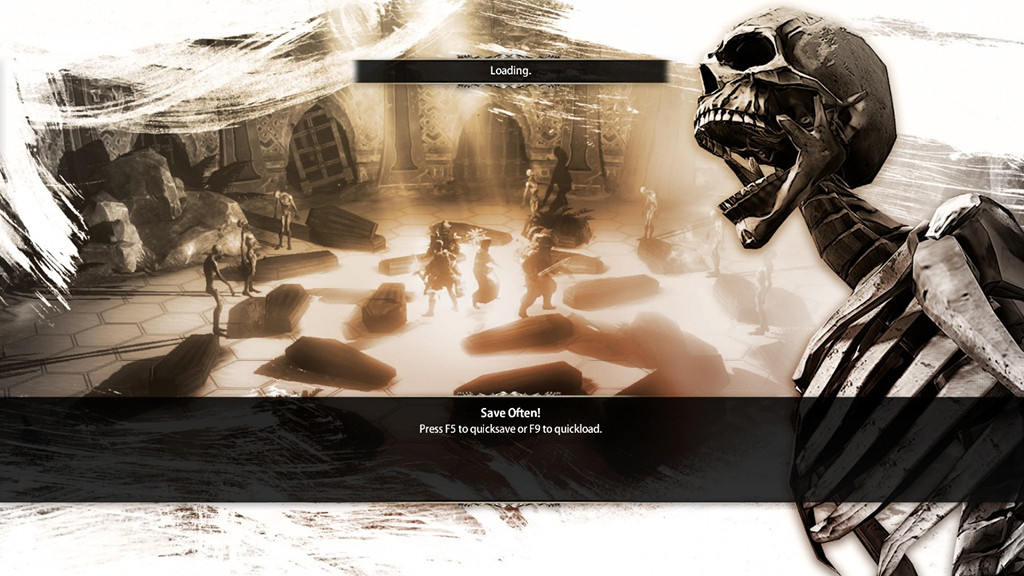
Next we move on to spells. There’s actually a very wide selection of them in the game, 24 in total. Furthermore, each spell also has four ranks, and each of these often adds entirely new functionality to the spells, not just increased numbers. The spells are split fairly well between offense, defense and support, and include your typical fireballs, heals and buffs, as well as a spell that creates an impenetrable barrier of 1-4 hexes, and another one that spawns a shadow-clone of the caster. Some of these spells are absolute must-haves, like Balm Of Healing or Clarum Plurum (antidote), some are even hilariously broken and make you feel dirty each time you use them (level 3 of Move As The Lightning, which gives a character another action per turn), and there’s only a small handful that are ridiculously bad (Witch Spit. Don’t use it. It’s a trap). That said, mages in The Dark Eye don’t really turn into walking engines of doom as they reach higher levels like in D&D, so don’t expect to be slinging fireballs every turn. Most of the straight-up damaging spells are VERY mana-costly, and useful only in emergencies or when something needs to be focus-fired.
Last are the special abilities, which are talents that come into use in combat. Most of them are passive and grant stat boosts or status effects like increased astral point regeneration. However, there are also a whole bunch of active combat abilities for melee and ranged characters, such as a knockdown blow or an armour-piercing shot. There are only a handful of these combat manoeuvres, and they're very useful, but it's quite a shame that they are so poorly described in-game. Power blow increases the damage done, okay, but by how much? And then there’s feint, which is only said to increase your chance to hit in game, but the manual says its damage is lower as a compensation (again, by how much exactly?). It's fairly obvious that all of these special attacks (except feint) have reduced chance to hit, but even that is not really specified in the tooltips.
You are restricted to a limited selection of spells and special abilities at character creation, and if you want to unlock more, you’ll have to find the appropriate trainers. Unfortunately, most of the trainers with an actual selection of abilities to offer (and not just a starting power blow) only show up around the middle of the game, which considerably constrains character development in the first two chapters. Even after that, they are not always easy to track down and only “unlock” when you do specific side quests.
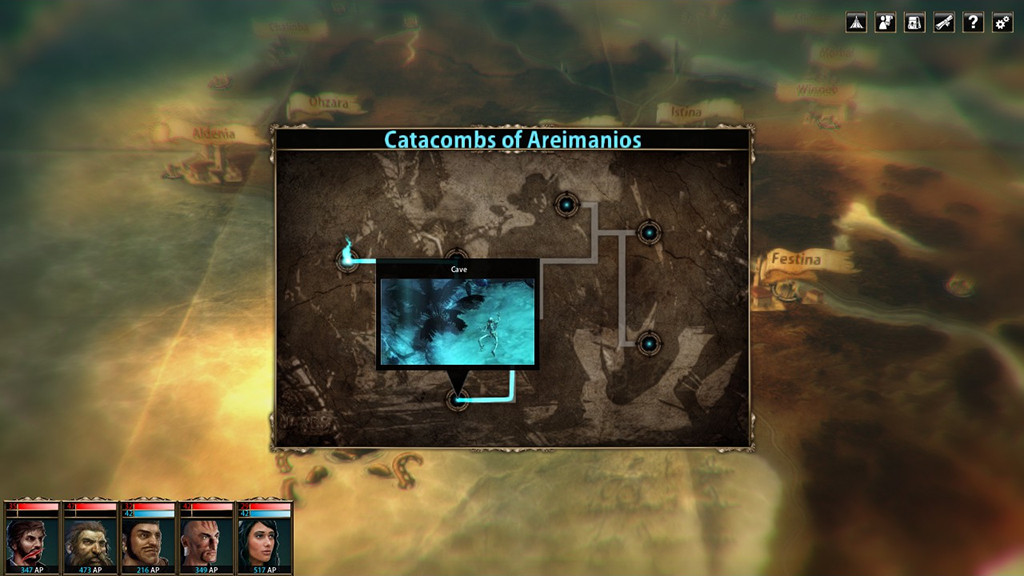
There are only two significant flaws when it comes to the game’s character system, and both are not really related to the system itself. One is the rather serious disproportion when it comes to adventure point gain. Like I said, early on you don’t really meet many good teachers and your characters are sort of “frozen”. Conversely, by the beginning of the fourth chapter, most of your characters will already be “fully” developed, but you’ll still be getting ludicrous amounts of AP that you can only spend on secondary stats. These are by no means useless, but it still has the feeling of “dumping unnecessary XP”. The second big problem is that archers are really cool to have around. Why is that a problem you ask? Because the game never really gives you a reliable archer companion, so unless your main character is a dedicated ranger, well, you are shit out of luck. Sure, you can repurpose one of your companions into an archer (it is usually a good idea to slap a bow on a mage to give him something to do while regenerating mana) but none of them really start with good archery-related stats, so they’ll be gimped for a while. This problem is exacerbated by the game’s strict narrative structure, that tends to reshuffle your party regularly without letting you keep dude_A instead of dude_B.
Blackjack Guillotine
Fighting. There’s a lot of it. In fact, it is pretty clear to me that if you don’t like combat-centric RPGs, you will not like Blackguards. However, if you do like RPG combat, this game presents a very rare treat that is fairly unique within the spectrum of the cRPG genre, and I can say that with a straight face. It achieves that thanks to a few factors, the primary one being its excellent encounter design.
You see, Blackguards seems to have a different design philosophy behind it compared to other RPGs. When you think about “difficulty” in other games in the genre, the first thing that comes to mind is usually those shitty solutions used by incompetent developers, like enemies with ridiculously bloated HP that kill you in one hit. Others will just keep the one-hit-kill part. More competent ones will come up with superior enemy AI and varied combat encounters. Daedalic obviously went for the last solution, but even then, their approach is still considerably different from other tacticool games you might have played, since it supplements mixed groups of enemies possessing different strengths and weaknesses with complex environmental interaction, that makes many of the game's fights feel a lot like puzzles. You will often be outnumbered and outgunned, against enemies armed with things like poisoned weaponry and traps, but you'll be able to offset that with careful tactical consideration and tool management.
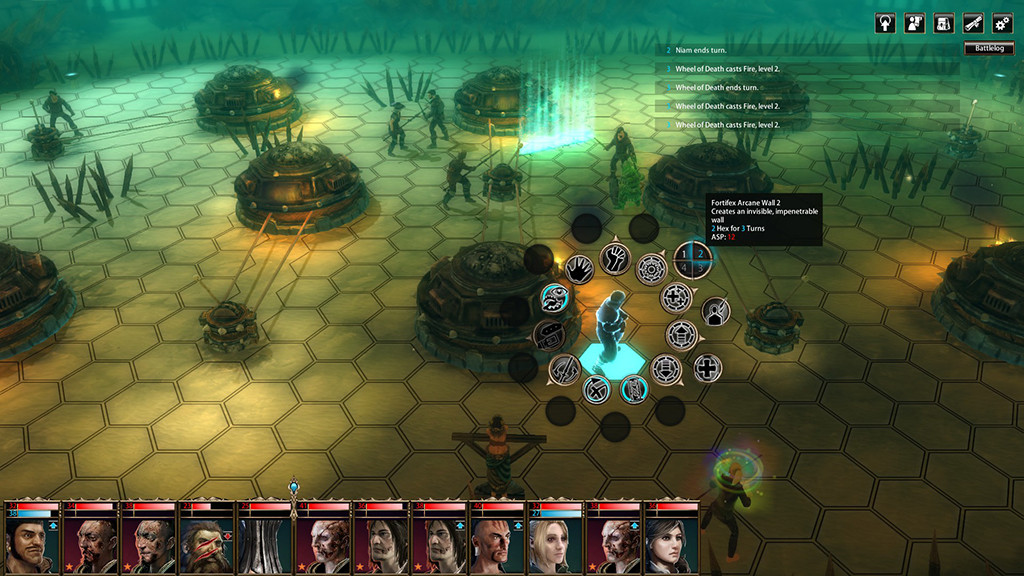
The great thing about Blackguards is that it encourages you to take risks. Rarely ever does a fight boil down to “I hit you, you hit me” - almost every character has so many options available to it that you will often plan a few moves ahead, thinking “if the knockdown, followed by the debuff and the hammer blow succeed this turn, I’ll have them by the balls”. Of course, oftentimes few or none of these maneuvers succeed, and then it is you who are held by the balls. The game's difficulty is consistently tough, and it feels extremely satisfying when you win a battle only by the skin of your teeth. The AI in particular deserves a commendation because it tends to be fairly clever. The enemies will often target your party members with just the right tool – your fat warriors will get debuffed, mages will get continuously knocked down and pestered, etc. Sometimes the enemy will even run past one of your dudes to waste his attack of opportunity and let everyone else move through safely to ravage your squishy backline. Unfortunately, there are a few instances where the foes will do something completely stupid like move back and forth without doing anything useful, or run straight through boiling lava, while other times they are very obviously scripted to start first and do something. Thankfully, that doesn’t happen very often. I also think that the game's higher difficulty levels introduce better AI routines, so that’s another plus.
I have to say that I liked how the encounter design shifted as the game progressed. Blackguards manages to smoothly avoid the pitfalls of most low-level pnp-based combat (aka missed hit bonanza) by focusing more on the environmental interaction in the first chapter. While engaging with mostly basic enemies, you’ll have to navigate around traps, push levers, avoid falling debris, etc. But as it goes further on, you start coming across more elaborate foes, while the envirohazards take on a more secondary role as convenient helpers or annoyances. You'll be be effectively challenged by both straight-up brawls and gimmicky contraptions as the game's battles steadily evolve into full-scale tactical challenges, time-limited carnages and mage duels. Some of the highlights include a questline that pits you against a guild of ridiculously deadly assassins, and a series of fights against deft Moha “indians” that weaken you with wounding weaponry and truckloads of poisoning traps and tripwires.
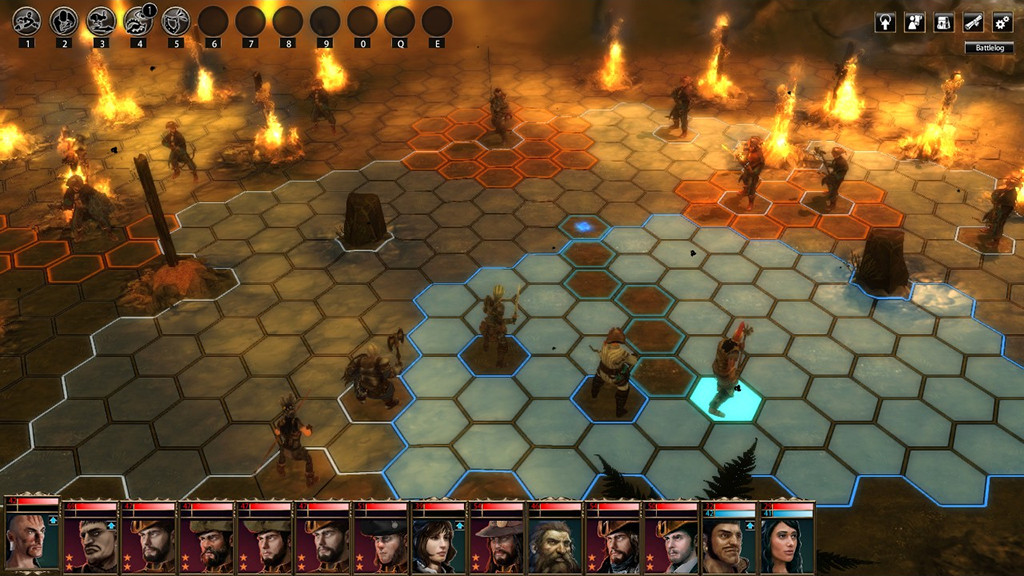
All that being said, when it comes to encounter design, the game does have four general problems. One is that sometimes you need to interact with the stuff strewn around the battle maps, but it is not explained at all whether you are actually doing it right (I’m looking at you, chapter 5), not even with the subtlest visual cues. Second is that whoever designed some of the set-pieces must have been drunk. There's the infamous crypt lice maze, in which you can spend a whole damn hour whacking overgrown bugs that respawn unless you shamelessly cheese it, or a map where you have to kill a total of 18 tentacles that pop in and out of the ground each turn. The third and probably the biggest problem is how the quality of the encounter design takes a considerable nosedive in chapter 4. Throughout the game you keep fighting all sorts of undead, wildlife, mercenaries, thugs, militiamen, etc, but chapter 4 essentially boils down to kicking around the exact same mob of what can be only described as gangs of epic-level peasants on crack, with little to no variety among them. Finally, the fourth problem is that when moving between chapters, you’ll find yourself in “flashback” fights, where your character retains his char-gen stats. These were most likely also designed by the drunk guy because they don’t really bring anything to the game, and are mostly very annoying. They range from ridiculously easy, through overlong and annoying, to one that is probably even more infamous than the lice maze, and might actually be the hardest battle in the game – your character plus a fairly useless caster against a mob of respawning crypt lice. Have fun.
I hate crypt lice.
Leaving encounter design behind, let’s say a few words about the mechanics. To be honest, the rules of The Dark Eye are ridiculously bloated and heavy on intertwined d20 dice rolls, but fortunately you don’t really feel that much in the game, and it’s enough to just know which stats matter for which activity. The game’s combat log doesn’t really help you in understanding the system because it barely shows anything useful. Instead, there is a highty informative “rules” section (which is actually a shameless copy of a Steam guide written by our own Felipepepe) that explains almost all the intricacies of the system. Reading through it is a very good idea, and it might save you from looking like an idiot when you claim that everything in the game is completely opaque and poorly explained.
The fights take place on hex-grid battle maps with ToEE-style initiative bars. Your characters have two actions to spend each turn – moving and acting (cast a spell, attack, double move, etc). Spells may fail during casting, attacks can do critical damage, wounds may be applied. All characters can take a max amount of 3 wounds, each of them cumulatively applying more and more stat penalties, and they can only be healed in towns, or by using high-level healing spells or the treat wounds talent. Enemies that drop to zero health are removed from combat, but your jolly fellows have a grace period of 3 turns to be healed back on their feet before they vanish from the map (but note that while on the ground they will keep taking damage every turn from poisons and area effects). There is no permadeath or resurrection in the game, and you only lose if all your party members fall.
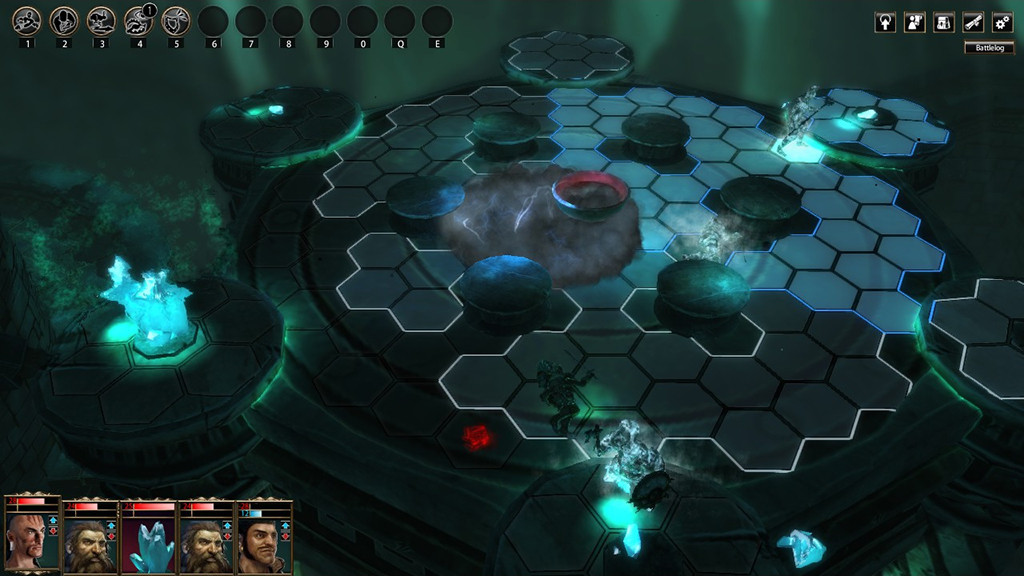
All spells and ranged attacks require line of sight. This can sometimes get really wonky (like a chest-high rock or an arch completely obstructing view), but there’s one aspect of it that I really liked – it takes into account a character’s posture and stance. You may target a guy standing behind a crate, but not anymore once he’s knocked down. Shorties like dwarves and goblins are also completely obstructed by small objects, but on the other hand, you can also shoot or use long-reach weapons like spears over them. Neat.
There’s not really much to talk about when it comes to the game's basic mechanics. They're fairly uninteresting and mostly in the background – roll ten d20 vs enemy ten d20, decide outcome. Which is why we can proceed to one of the game’s biggest problems - the itemization.
As I said before, the game lets you employ lots of different tools in combat – not just special abilities and spells, but also weapons with different damage types, differently focused armour sets, poisons, traps, special ammunition and even grenades. But just about each of these is flawed in some way.
The weapons are probably the biggest offender. Sure, the eight different types might make you think there is a lot of flexibility, and the same when it comes to armour having all sorts of resistances, or enemies like skeletons being immune to piercing damage. But the sad fact of the matter is that some of the weapons are considerably overrepresented, while others are absolutely neglected. For instance, at one point the game was simply showering me with two-handed swords and axes, but my dual-wielding warrior was using fencing weapons and swords. I picked up a generic “sword” from a merchant at the beginning of chapter 1, and I had to stick with it till the end of chapter 4, when I FINALLY found the only sword in the game better than a “sword”. Fencing weapons suffer from the same problem. Meanwhile, Naurim the axeman dwarf could choose between a bashing axe, a fire axe and a magic axe for each battle, two of which also had stat bonuses.
Armour is cool because all the chain and plate suits look fairly realistic without any gigantic pauldrons, and they have lots of different damage resistances, varying levels of stat-decreasing encumbrance, and some can even be combined into sets that further increase their armour ratings (base damage reduction). But why can I combine a chain coat or gambeson clothes into a set, but not a caftan or a robe (the latter being very hard to assemble)? Once again, heavy hitters have many sets to choose from, with various pros and cons, but non-armoured dudes need to use chapter 1 gambeson or leather until late in chapter 5.
Felipepepe: Again, I agree. I think it's valid and interesting design choice if a game wants to make magical items rare, and I’m not asking for Diablo-style loot madness, but come on! About 1 hour into the game I bought a leather set for my character... 15 hours and 4 chapters later he was still using the exact same set. And while there’s more variety for weapons, the sense of progression isn’t great.
In another example of the game’s annoying lack of documentation, you’re told that increasing your Strength increases your damage with some weapons, each type having different modifiers and limits, but that is never shown nor explained in detail. My two-handed sword's damage is shown as 6-11, but I can’t see the attribute bonuses that are applied on top of that anywhere, or even what my critical chance/modifier is. Now combine that with a simplistic battle log that doesn’t display rolls and calculations, and an armor system built around resistances and damage reduction, and the result is that I have absolutely no idea what the actual damage output of my character is. Is he simply doing the same amount of damage he was ten hours ago, or is he doing much more now, but the enemies' DR has also increased? Tell me, game!
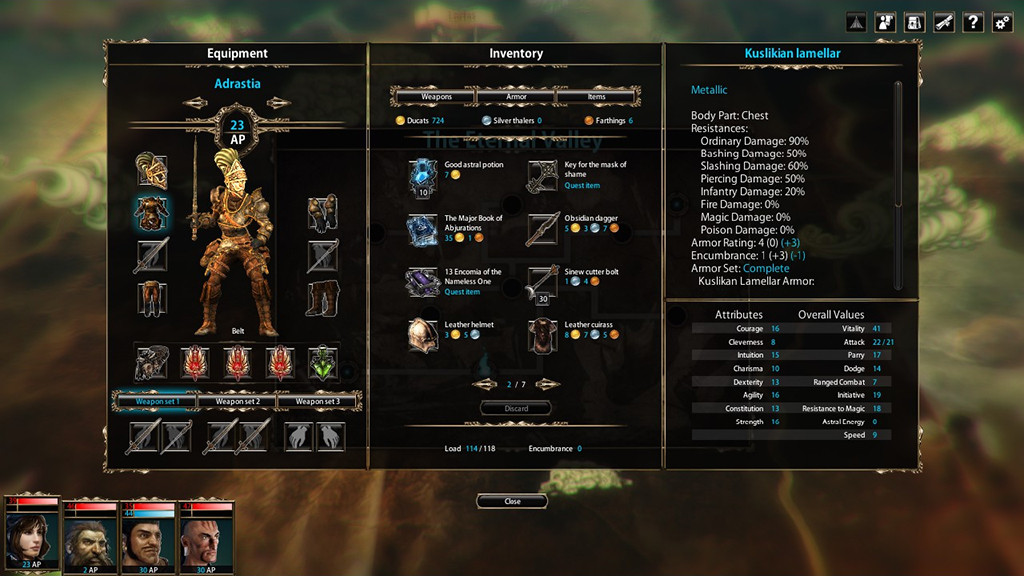
When it comes to limited supplies, such as poisons or special ammunition, the problem is mostly that they're not really that limited. By the beginning of chapter 3, you’ll be swimming in so much money that you’ll be able to buy all the items you want, and if you've mastered the combat system, you won’t really need them that often. Furthermore, the same drunk person that designed the lice maze must have also set the item prices, because quite often significantly inferior items cost more than the better ones. And then there's the traps and grenades. You can forget about setting traps because they're not really worth it. You’re better off killing a guy with a triple shot instead of wasting a turn to set up a trip wire. As for grenades, those are actually crazy good and sometimes game-changing because they inflict various status effects (such as frenzy, sleep, etc), but they're also very rare and need a pretty high throwing skill to use effectively...and all the other throwing weapons are complete garbage.
The last thing to mention when it comes to combat and mechanics are the difficulty levels, which are another of Blackguards’ strengths. Increasing the difficulty level really alters the gameplay experience significantly. The composition of enemy encounters isn't changed, but the enemies themselves receive much better stats, more advanced AI routines, and only slightly higher HP. With the multitude of different character builds that the game allows, there is much more replayability here than meets the eye. After first playing through on normal with an archer, I thought that a replay would end up as a chore, but I found that upping the difficulty to hard and switching to a dual-wielding warrior made for an experience that was completely different, and just as fun as the first playthrough.
There and black again
Blackguards takes place in the southern parts of Aventuria – the southern reaches of the Horasian Empire and the Emirate of Mengbilla, i.e. fantasy medieval Italy and Spain. There isn’t a lot when it comes to landscapes and dangerous travel because the travel and exploration systems have been by and large cut down to the necessary minimum.
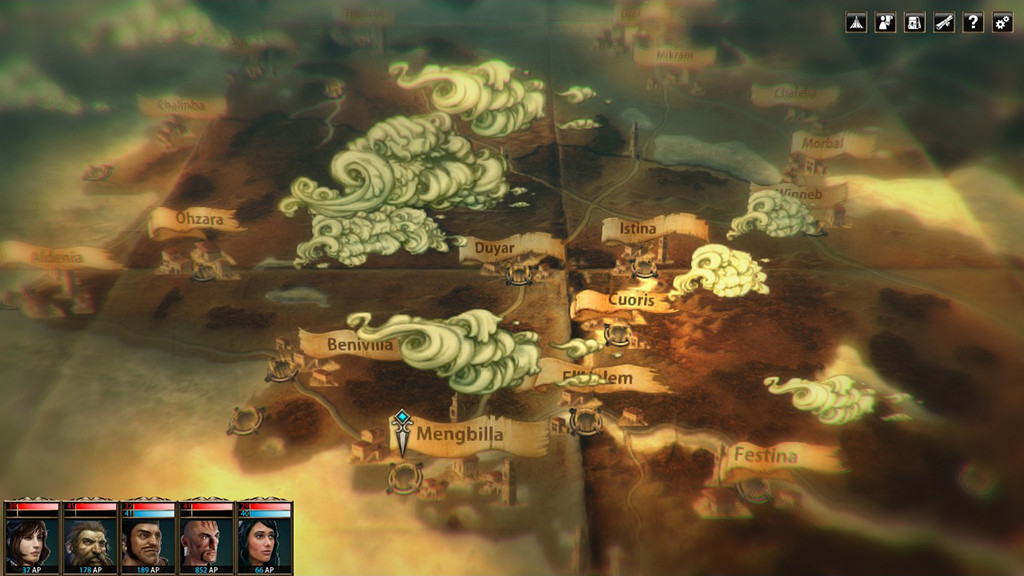
Sure, the nicely animated in-game overland map is fairly big and looks like it’s full of cities and opportunities, but that’s mostly a smokescreen. An effective one, but a smokescreen nonetheless. The only activities you can do on the map are travelling from city to city and resting to full health if you have provisions. The time you spend on the map in-between various activities doesn’t matter at all - I don’t think the game even tracks the time. There are no random encounters along the way either, only some scripted ones every now and again. Cities are for the most part just static screens with vendors, healers and quest-givers, and only a few of them have more than one screen. “Dungeon” “exploration” presents you with a simple map with a few waypoints marked on it, which in 90% of cases represent a fight. You could say that at least they're not completely railroaded, and they do allow for some very minor additional activities, very rarely even offering some kind of a secret.
Yeah, that doesn’t really sound like much, but it didn’t bother me too much while playing. The game clearly knows its focuses and its limitations, and while it’s a shame that the exploratory aspects had to be cut so drastically (supposedly, the original plan was to include random encounters and more elaborate dungeon maps), I appreciate the elegance with which it was done. The city interfaces are attractive and functional, the dungeon maps straightforward without feeling half-assed, and the abundance of smaller towns on the map manages to grant the illusion that you are spending your time travelling and questing in an open world, although I can only wonder why one or two of them have nothing more than an innkeeper.
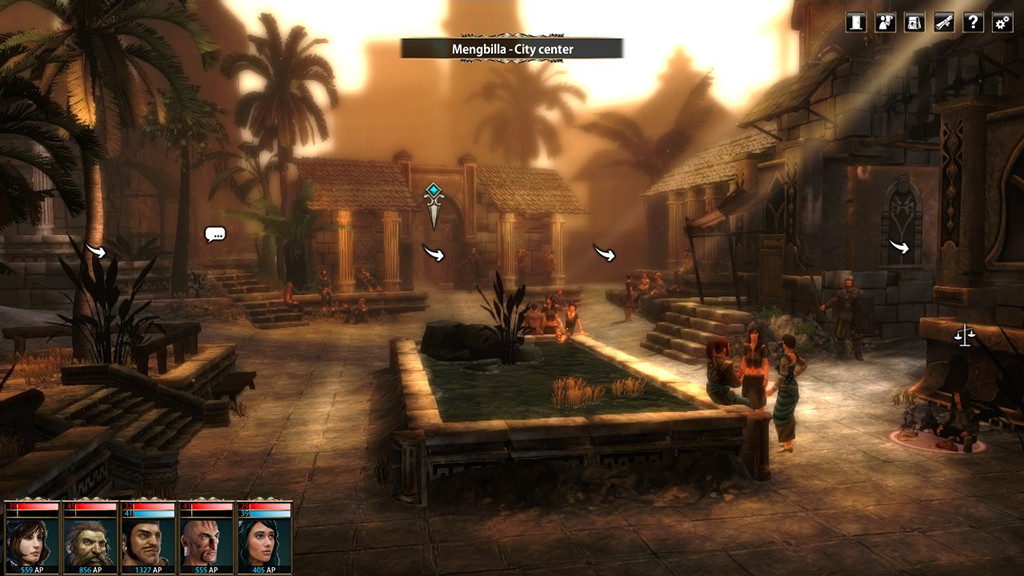
The questing is kind of the funny part of this game. The vast majority of it boils down to “get quest, go kill something, return for reward” or “go fetch something, return for reward”, which sounds pretty horrible on paper. In practice, however, the game sucks you in so effectively that you don’t want to stop playing. When I realized this, I said to myself, “a combination of fights and fedex quests like that has no right to be this goddamn absorbing”. Looking back, I think it's a combination of three things. The first is that the quests often have an interesting premise. For example, trapping a giant gorilla in a suspended cage. The second is, of course, that they so often end with a brilliant combat scenario. And third is that most of them aren’t very long or multi-scenario-spanning, which gives you that feeling that's so characteristic of 4x strategy games, i.e. “JUST... ONE... MORE... TURN...”.
The quests often have two to three ways of completing them, usually boiling down to “fight or bribe” or “pick outcome x or outcome y”. And here’s another funny thing - Blackguards loves to troll you. Bribing yourself out of combat is almost always the “wrong” choice, so to speak, because it always deprives you of combat AP and loot. Also, sometimes (but rarely) the alternate ways of accomplishing quests are not exactly obvious. And finally, the game tends to shamelessly laugh at the times you want to be a hero – there is no karma or reputation system present, and “doing the right thing”, like letting a slave girl go free instead of bringing her back to her master won’t give you a penny. Sure, this could be seen as a flaw, but on the other hand, it’s a nice slap back into a reality where no good deed goes unpunished. Choices and consequences! Speaking of choices, there aren’t many hugely game-changing ones, but there are a few that sure as hell count, and even have very long-reaching consequences that, once again, tend to troll you mercilessly.
One thing that I didn’t like about some quests, though, was that they tended to end very abruptly, with some loose ends still untied, or with information or items that look like they should lead you somewhere further, but never do.
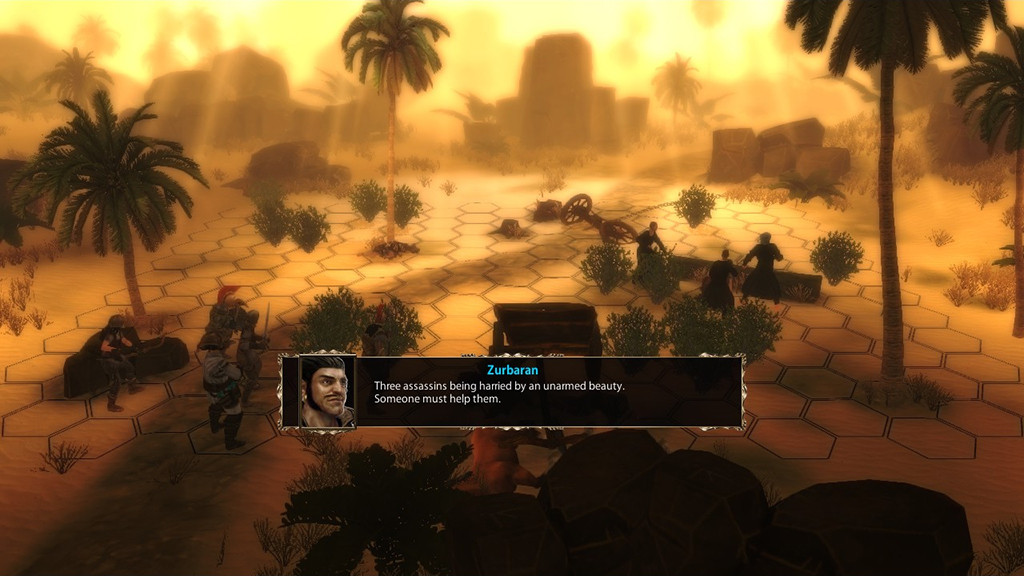
Finally, we can address Blackguards’ biggest and most surprising flaw. The narrative. The main story is a predictable and messy series of cliches and plot-induced character stupidity, and if you can add 2+2, you’ll probably figure out most of it very quickly. Another thing the game fails at is properly presenting the whole “grimdark world where you control a party of criminals” shtick. The main story quickly devolves into “save the world!!!”, while the sidequests meander between kicking kittens for laughs and goodly charity work. This is a shame because Daedalic are known for crafting really good and atmospheric narratives, and Blackguards does have some powerful themes (betrayal, slavery, torture), but seems to be too scared to take them one step further. This is probably most apparent when it comes to the characters you control. Ok, so these blokes are supposed to be terrible criminals: a dwarf with a bad temper, a gigolo foreigner mage, a half-elf junkie, etc. But they're all scoundrels at worst, and none of them are repulsive. In fact, all of them become downright likeable as you keep on playing. To make things worse, it often feels like they are walking loose ends, as well. There are many times when something is heavily implied about one of the party members, but it never goes anywhere. “Oh, so you probably poisoned that baron dude? Ok cool, let’s move on”. Hell, even the friggin’ manual has lots of interesting information about every companion, information that is never mentioned in the game itself.
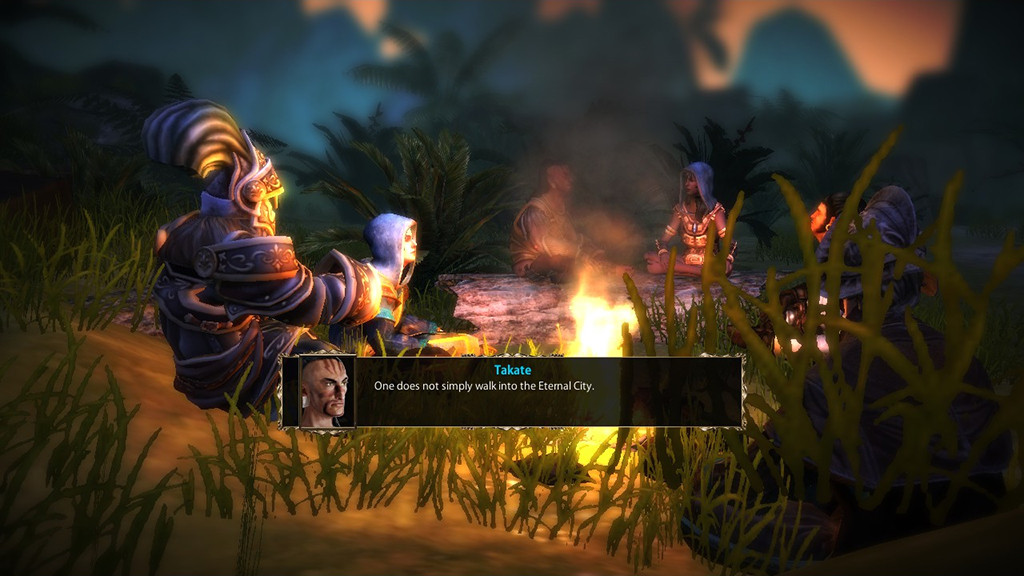
Regardless, at least one thing that Blackguards definitely retains from other Daedalic games is the writing quality. Apart from the inability to produce proper grimdarkness, all of the dialogues and texts are very solid. If I had to compare them to another game, I’d say they’re most reminiscent of Gothic – very down to earth, serious when they need to be, and sometimes fairly witty. Must be some kind of a Teutonic school of writing.
Blackout
When it comes to the technical aspect of things, the game is fully functional for the most part, with a few reservations.
The combat interface is slick and readable. You get a customisable hotkey array, there’s an initiative bar, every ability is sorted in a fairly decent radial menu, and you generally know what’s going on at all times. One thing that sometimes annoyed me, however, was that you can’t rotate the camera during combat, only change the vertical view angle. This leads to lots of misclicking and a need for precise mouse aiming skills when a small character is standing behind a big one, for example.
Graphics-wise, it’s obvious that Daedalic’s talented artists were trying their best to squeeze all the juice out of the shoddy Unity 3D engine. They mostly succeeded, as most of the battle maps, cities and environments look nice enough, but the amount of non-adjustable bloom splurged all over everything is simply ridiculous at times. Also, speaking of Unity, I don’t know whether it’s because of bad coding or the engine itself, but the fact that the game takes up 22.5 GB of disk space (4 of which are “making of” bonus materials MP4s...) is downright preposterous.
Felipepepe: There was obviously a lot of effort and passion involved in the development of this game. You can see it in the attention to small details, like how almost every enemy has a unique portrait, even if it’s just a small change, like a mustache or slightly darker skin. The battle maps are very well done and give you the impression that you are indeed in the middle of a dense forest, landing on the shores of a remote island or crossing a vast desert. I’m not a fan of bloom and depth of field, but the artists used them quite well in some places, especially in the wilderness areas.

Sound effects are fairly generic, but the background music is very good. Voice acting ranges from serviceable to good, though voice actors are often recycled. The party members' voice acting definitely deserves a commendation, particularly that of Naurim the dwarf and Zurbaran the gigolo mage. Especially the latter, whose laid-back attitude and heavily accented and slow manner of speech really add a lot to his character. Moreover, party members and enemies sometimes yell out stuff in combat as a reaction to various status effects, which also adds a lot of personality to the fights.
As for stability and bugs, here things can sometimes get nasty. The game crashes and freezes way more often than I’d like, especially in combat, though at least it usually has the decency to crash right when a battle starts (which isn't exactly helpful during back-to-back combat sequences that don't give you the opportunity to save in-between battles, however). I haven’t encountered any truly game-breaking bugs in the game, but there are a few very irritating ones. For example, the Blade Storm ability (which is already fairly useless as it is) causes the game to freeze if it kills an enemy. There is also an infamously difficult fight at the end of the game that apparently made many people pull their hair out in rage. One of the developers chimed into a discussion about it on the game's Steam forum and basically said “hey guys, those slugs shouldn’t actually be respawning, sounds like a bug”.
The word you are looking for is “coloured”
It took me a whopping 68 hours to play through Blackguards twice, and it was a blast. In the earlier preview I said that I haven’t had that much fun whacking stuff in turn-based combat since Knights of the Chalice, and I definitely stand by that statement. Blackguards offers a very bountiful catch for any combat-focused RPG connoisseur, delivering tremendous fun and challenge at the expense of story of worldbuilding (fortunately, bad narrative is much easier to ignore than bad gameplay). Its vast array of character builds and its difficulty levels give it more replay value than you’d expect.
For a first-time RPG developer, Daedalic Entertainment have done a surprisingly splendid job with Blackguards. I can only hope that if they decide to continue making RPGs, they’ll build upon this foundation and add in all the elements that it currently lacks.
It's taken us long enough since that preview and the game's official release in January, but we are now ready to present our final verdict on Daedalic's RPG debut, penned again by Darth Roxor and felipepepe. Has their opinion of the game changed since the preview? Read on to find out.

[Written by Darth Roxor, with additional commentary by Felipepepe. Edited by Infinitron.]
Blackguards – kicking ass and taking names
When Blackguards was first announced back in 2013, I largely ignored it because it had all the trappings of potential shovelware – Unity engine, a company that had never made RPGs, and shady promises of turn-based combat. However, it was still a game from Daedalic Entertainment, a German developer known for their good to brilliant adventure games (Chains of Satinav and Memoria, among others), so it was at least possible that the game would come with a very good narrative and puzzle-solving aspect.
Out of sheer curiosity, I applied for the game's closed beta, and hot damn, was that a completely mind-changing experience. Felipepepe and I described our very positive impressions of the game in our preview after it was released on Steam Early Access. But in the beta days, I only finished two out of five chapters the game had promised me, and I was very curious whether it would be consistent to the end.
And the answer is: oh hell yes it would.
Agents of Black
Before you start the game, you get to create your very own scum of the earth. Blackguards is a party-based game, with up to five characters present in your party, but you only create the main character, and all the others join up over the course of the story. The character creation can be done in two ways: either by selecting one of three pre-set backgrounds (warrior, hunter, mage) with no customization other than purely cosmetic gender, name and portrait, or by creating a character from scratch.

When manually creating a character, you are given 10,000 adventure points (the game’s equivalent of experience) to spend around as you like, although with some limits applied to maximum levels and available talents and spells. The ruleset is based on a later edition of Das Schwarze Auge, a pen and paper roleplaying system that is very popular in Germany, and a lot of its complexities are carried into the game, apparently without too many concessions for the computer gaming platform. This means you will likely feel overwhelmed by the sheer number of categories in which you can drop your skill points, and your inner munchkin will squeal with glee when analysing how the various statistics, spells and talents interplay. Needless to say, because of this it is also incredibly easy to completely screw up at character creation if you are doing it for the first time, and it doesn't help that you don’t have access to Blackguards' in-game rule guide at this stage either. The PDF manual is also fairly useless when it comes to explaining the rules, so you have to rely solely on the tooltips, which don’t explain all of the secrets of the system. The insane amount of stuff that you can customize leaves a lot of room for specialising and min-maxing, and it’s pretty satisfying to see your character grow in power, especially considering that some builds take considerably more time to “perfect”.
The character system has five categories of statistics – base values, weapon talents, talents, spells and special abilities.
Base values are your typical Strengths, Agilities, Charismas, etc. These are the most costly to raise, but they also have the greatest effect on your character build. For example, raising Agility will improve your attack, dodge, parry, initiative and speed rates. Some of the base values also have additional effects, such as supporting spellcasting or increasing a character’s resistance to wounds, and none of them can really be considered “dump stats” in the general scheme of things. Sure, some classes won’t find any use for a few of the stats (for example, a warrior will never need Charisma) but there’s no stat that nobody needs. Except Astral Energy (mana) and Vitality (health), I guess, because while fairly cheap, getting them through other stats is a much better investment. Next to Astral Energy and Vitality, you can also find Magic Resistance, which looks fairly uninteresting at first glance, but let me tell you here that you are going to have a very bad time if you don’t start putting points into it around the middle of the game.

Next we have weapon talents, which are pretty straightforward. There are eleven of them, three ranged, eight melee, and they each improve a character’s parrying or attacking capabilities. The neat thing is that you can constantly change how many points in the talent you want to put into attacking, and how many into parrying. This is particularly useful for dual-wielding, where one hand can be allocated fully to defense, and the other to offense.
Next up are talents, which are essentially character skills that have active and passive uses, with more boons unlocking as you level them up. There are nine of them in total, and they can generally be divided into three categories: completely useless, one-point wonders and must-haves. Treat wounds, for example, is a total waste of AP because it becomes outclassed very quickly by the Balm Of Healing spell. Perception, on the other hand, is a must-have unless you want to fall into every possible trap. Streetwise is generally good enough with one point in it, to increase your speed in urban areas, although it’s still pretty nifty at later ranks, as it further increases the speed bonus, and also grants boosts to agility and cleverness.

Next we move on to spells. There’s actually a very wide selection of them in the game, 24 in total. Furthermore, each spell also has four ranks, and each of these often adds entirely new functionality to the spells, not just increased numbers. The spells are split fairly well between offense, defense and support, and include your typical fireballs, heals and buffs, as well as a spell that creates an impenetrable barrier of 1-4 hexes, and another one that spawns a shadow-clone of the caster. Some of these spells are absolute must-haves, like Balm Of Healing or Clarum Plurum (antidote), some are even hilariously broken and make you feel dirty each time you use them (level 3 of Move As The Lightning, which gives a character another action per turn), and there’s only a small handful that are ridiculously bad (Witch Spit. Don’t use it. It’s a trap). That said, mages in The Dark Eye don’t really turn into walking engines of doom as they reach higher levels like in D&D, so don’t expect to be slinging fireballs every turn. Most of the straight-up damaging spells are VERY mana-costly, and useful only in emergencies or when something needs to be focus-fired.
Last are the special abilities, which are talents that come into use in combat. Most of them are passive and grant stat boosts or status effects like increased astral point regeneration. However, there are also a whole bunch of active combat abilities for melee and ranged characters, such as a knockdown blow or an armour-piercing shot. There are only a handful of these combat manoeuvres, and they're very useful, but it's quite a shame that they are so poorly described in-game. Power blow increases the damage done, okay, but by how much? And then there’s feint, which is only said to increase your chance to hit in game, but the manual says its damage is lower as a compensation (again, by how much exactly?). It's fairly obvious that all of these special attacks (except feint) have reduced chance to hit, but even that is not really specified in the tooltips.
You are restricted to a limited selection of spells and special abilities at character creation, and if you want to unlock more, you’ll have to find the appropriate trainers. Unfortunately, most of the trainers with an actual selection of abilities to offer (and not just a starting power blow) only show up around the middle of the game, which considerably constrains character development in the first two chapters. Even after that, they are not always easy to track down and only “unlock” when you do specific side quests.

There are only two significant flaws when it comes to the game’s character system, and both are not really related to the system itself. One is the rather serious disproportion when it comes to adventure point gain. Like I said, early on you don’t really meet many good teachers and your characters are sort of “frozen”. Conversely, by the beginning of the fourth chapter, most of your characters will already be “fully” developed, but you’ll still be getting ludicrous amounts of AP that you can only spend on secondary stats. These are by no means useless, but it still has the feeling of “dumping unnecessary XP”. The second big problem is that archers are really cool to have around. Why is that a problem you ask? Because the game never really gives you a reliable archer companion, so unless your main character is a dedicated ranger, well, you are shit out of luck. Sure, you can repurpose one of your companions into an archer (it is usually a good idea to slap a bow on a mage to give him something to do while regenerating mana) but none of them really start with good archery-related stats, so they’ll be gimped for a while. This problem is exacerbated by the game’s strict narrative structure, that tends to reshuffle your party regularly without letting you keep dude_A instead of dude_B.
Felipepepe: I agree with both points, especially the second one. One of the strengths of Blackguards is how it offers possibilities for exotic builds when creating your character, especially various shades of fighter/mage hybrids. However, at the same time you’re somewhat restricted by the party members the game imposes on you. For most of the game you’ll be stuck with 2 fighters and 2 mages, which means that not only will you be missing an archer, but that creating your character as a pure mage might leave you too squishy. I can’t help but think about how cool it would be to have a cast of diverse party members to choose from, or to be able to create all of them. But I would settle for at least being able to choose who to keep at those party reshuffling story points.
That plus the lackluster documentation means at some point you’ll probably be upset with your first party and feel the urge to restart the game, this time using your newly acquired meta-knowledge, especially when playing on Hard. Bro-tip: wait until the start of Chapter 3 if you’re thinking of doing this.
That plus the lackluster documentation means at some point you’ll probably be upset with your first party and feel the urge to restart the game, this time using your newly acquired meta-knowledge, especially when playing on Hard. Bro-tip: wait until the start of Chapter 3 if you’re thinking of doing this.
Blackjack Guillotine
Fighting. There’s a lot of it. In fact, it is pretty clear to me that if you don’t like combat-centric RPGs, you will not like Blackguards. However, if you do like RPG combat, this game presents a very rare treat that is fairly unique within the spectrum of the cRPG genre, and I can say that with a straight face. It achieves that thanks to a few factors, the primary one being its excellent encounter design.
You see, Blackguards seems to have a different design philosophy behind it compared to other RPGs. When you think about “difficulty” in other games in the genre, the first thing that comes to mind is usually those shitty solutions used by incompetent developers, like enemies with ridiculously bloated HP that kill you in one hit. Others will just keep the one-hit-kill part. More competent ones will come up with superior enemy AI and varied combat encounters. Daedalic obviously went for the last solution, but even then, their approach is still considerably different from other tacticool games you might have played, since it supplements mixed groups of enemies possessing different strengths and weaknesses with complex environmental interaction, that makes many of the game's fights feel a lot like puzzles. You will often be outnumbered and outgunned, against enemies armed with things like poisoned weaponry and traps, but you'll be able to offset that with careful tactical consideration and tool management.

The great thing about Blackguards is that it encourages you to take risks. Rarely ever does a fight boil down to “I hit you, you hit me” - almost every character has so many options available to it that you will often plan a few moves ahead, thinking “if the knockdown, followed by the debuff and the hammer blow succeed this turn, I’ll have them by the balls”. Of course, oftentimes few or none of these maneuvers succeed, and then it is you who are held by the balls. The game's difficulty is consistently tough, and it feels extremely satisfying when you win a battle only by the skin of your teeth. The AI in particular deserves a commendation because it tends to be fairly clever. The enemies will often target your party members with just the right tool – your fat warriors will get debuffed, mages will get continuously knocked down and pestered, etc. Sometimes the enemy will even run past one of your dudes to waste his attack of opportunity and let everyone else move through safely to ravage your squishy backline. Unfortunately, there are a few instances where the foes will do something completely stupid like move back and forth without doing anything useful, or run straight through boiling lava, while other times they are very obviously scripted to start first and do something. Thankfully, that doesn’t happen very often. I also think that the game's higher difficulty levels introduce better AI routines, so that’s another plus.
I have to say that I liked how the encounter design shifted as the game progressed. Blackguards manages to smoothly avoid the pitfalls of most low-level pnp-based combat (aka missed hit bonanza) by focusing more on the environmental interaction in the first chapter. While engaging with mostly basic enemies, you’ll have to navigate around traps, push levers, avoid falling debris, etc. But as it goes further on, you start coming across more elaborate foes, while the envirohazards take on a more secondary role as convenient helpers or annoyances. You'll be be effectively challenged by both straight-up brawls and gimmicky contraptions as the game's battles steadily evolve into full-scale tactical challenges, time-limited carnages and mage duels. Some of the highlights include a questline that pits you against a guild of ridiculously deadly assassins, and a series of fights against deft Moha “indians” that weaken you with wounding weaponry and truckloads of poisoning traps and tripwires.
Felipepepe: I said it in the preview, and I’ll repeat it here: Daedalic’s vast experience in adventure games can be fully felt in the way they approach encounter design. Baldur’s Gate 2 is often praised for its vast bestiary and great encounter design. I dare say that Blackguards has equally great encounter design, although from a different “school”.
Since every encounter happens in a unique arena specifically designed for it, the developers had the freedom to play with various things. There are holes that spawn enemies, time limits, movable and destructible objects, healing orbs, falling chandeliers, mechanical blades, flying dragons, falling stalactites, rotating fire traps, swamp gas, giant tentacles, mind-controlling plants, draw bridges, collapsing passageways, a giant cage on a crane… there is not a single RPG out there that offers so many interesting things to do during combat. Honestly, Blackguards is a lesson in encounter design that every RPG player AND developer should experience, to see what a creative team can do when thinking outside of the genre's standard templates. Daedalic even had the guts to make skeletons properly immune to arrows and swords, as they should be.
Since every encounter happens in a unique arena specifically designed for it, the developers had the freedom to play with various things. There are holes that spawn enemies, time limits, movable and destructible objects, healing orbs, falling chandeliers, mechanical blades, flying dragons, falling stalactites, rotating fire traps, swamp gas, giant tentacles, mind-controlling plants, draw bridges, collapsing passageways, a giant cage on a crane… there is not a single RPG out there that offers so many interesting things to do during combat. Honestly, Blackguards is a lesson in encounter design that every RPG player AND developer should experience, to see what a creative team can do when thinking outside of the genre's standard templates. Daedalic even had the guts to make skeletons properly immune to arrows and swords, as they should be.

All that being said, when it comes to encounter design, the game does have four general problems. One is that sometimes you need to interact with the stuff strewn around the battle maps, but it is not explained at all whether you are actually doing it right (I’m looking at you, chapter 5), not even with the subtlest visual cues. Second is that whoever designed some of the set-pieces must have been drunk. There's the infamous crypt lice maze, in which you can spend a whole damn hour whacking overgrown bugs that respawn unless you shamelessly cheese it, or a map where you have to kill a total of 18 tentacles that pop in and out of the ground each turn. The third and probably the biggest problem is how the quality of the encounter design takes a considerable nosedive in chapter 4. Throughout the game you keep fighting all sorts of undead, wildlife, mercenaries, thugs, militiamen, etc, but chapter 4 essentially boils down to kicking around the exact same mob of what can be only described as gangs of epic-level peasants on crack, with little to no variety among them. Finally, the fourth problem is that when moving between chapters, you’ll find yourself in “flashback” fights, where your character retains his char-gen stats. These were most likely also designed by the drunk guy because they don’t really bring anything to the game, and are mostly very annoying. They range from ridiculously easy, through overlong and annoying, to one that is probably even more infamous than the lice maze, and might actually be the hardest battle in the game – your character plus a fairly useless caster against a mob of respawning crypt lice. Have fun.
I hate crypt lice.
Leaving encounter design behind, let’s say a few words about the mechanics. To be honest, the rules of The Dark Eye are ridiculously bloated and heavy on intertwined d20 dice rolls, but fortunately you don’t really feel that much in the game, and it’s enough to just know which stats matter for which activity. The game’s combat log doesn’t really help you in understanding the system because it barely shows anything useful. Instead, there is a highty informative “rules” section (which is actually a shameless copy of a Steam guide written by our own Felipepepe) that explains almost all the intricacies of the system. Reading through it is a very good idea, and it might save you from looking like an idiot when you claim that everything in the game is completely opaque and poorly explained.
Felipepepe: Daedalic asked me to use the guide in their game, and while I'm happy to see it there, I wish they'd put more effort into their own documentation. They already did the hard part of creating a system people want to play - now all they need to do is allow us to understand it. Casual players may not care about the rolls and checks, but in a game like this, where meta-gaming and min-maxing is part of the fun, knowing all the details is vital. This has already improved a lot since the beta, but I hope they improve it more in future patches. I especially hope that they add an option to see the full battle log with all the rolls and checks that my heart desires.
The fights take place on hex-grid battle maps with ToEE-style initiative bars. Your characters have two actions to spend each turn – moving and acting (cast a spell, attack, double move, etc). Spells may fail during casting, attacks can do critical damage, wounds may be applied. All characters can take a max amount of 3 wounds, each of them cumulatively applying more and more stat penalties, and they can only be healed in towns, or by using high-level healing spells or the treat wounds talent. Enemies that drop to zero health are removed from combat, but your jolly fellows have a grace period of 3 turns to be healed back on their feet before they vanish from the map (but note that while on the ground they will keep taking damage every turn from poisons and area effects). There is no permadeath or resurrection in the game, and you only lose if all your party members fall.

All spells and ranged attacks require line of sight. This can sometimes get really wonky (like a chest-high rock or an arch completely obstructing view), but there’s one aspect of it that I really liked – it takes into account a character’s posture and stance. You may target a guy standing behind a crate, but not anymore once he’s knocked down. Shorties like dwarves and goblins are also completely obstructed by small objects, but on the other hand, you can also shoot or use long-reach weapons like spears over them. Neat.
There’s not really much to talk about when it comes to the game's basic mechanics. They're fairly uninteresting and mostly in the background – roll ten d20 vs enemy ten d20, decide outcome. Which is why we can proceed to one of the game’s biggest problems - the itemization.
As I said before, the game lets you employ lots of different tools in combat – not just special abilities and spells, but also weapons with different damage types, differently focused armour sets, poisons, traps, special ammunition and even grenades. But just about each of these is flawed in some way.
The weapons are probably the biggest offender. Sure, the eight different types might make you think there is a lot of flexibility, and the same when it comes to armour having all sorts of resistances, or enemies like skeletons being immune to piercing damage. But the sad fact of the matter is that some of the weapons are considerably overrepresented, while others are absolutely neglected. For instance, at one point the game was simply showering me with two-handed swords and axes, but my dual-wielding warrior was using fencing weapons and swords. I picked up a generic “sword” from a merchant at the beginning of chapter 1, and I had to stick with it till the end of chapter 4, when I FINALLY found the only sword in the game better than a “sword”. Fencing weapons suffer from the same problem. Meanwhile, Naurim the axeman dwarf could choose between a bashing axe, a fire axe and a magic axe for each battle, two of which also had stat bonuses.
Armour is cool because all the chain and plate suits look fairly realistic without any gigantic pauldrons, and they have lots of different damage resistances, varying levels of stat-decreasing encumbrance, and some can even be combined into sets that further increase their armour ratings (base damage reduction). But why can I combine a chain coat or gambeson clothes into a set, but not a caftan or a robe (the latter being very hard to assemble)? Once again, heavy hitters have many sets to choose from, with various pros and cons, but non-armoured dudes need to use chapter 1 gambeson or leather until late in chapter 5.
Felipepepe: Again, I agree. I think it's valid and interesting design choice if a game wants to make magical items rare, and I’m not asking for Diablo-style loot madness, but come on! About 1 hour into the game I bought a leather set for my character... 15 hours and 4 chapters later he was still using the exact same set. And while there’s more variety for weapons, the sense of progression isn’t great.
In another example of the game’s annoying lack of documentation, you’re told that increasing your Strength increases your damage with some weapons, each type having different modifiers and limits, but that is never shown nor explained in detail. My two-handed sword's damage is shown as 6-11, but I can’t see the attribute bonuses that are applied on top of that anywhere, or even what my critical chance/modifier is. Now combine that with a simplistic battle log that doesn’t display rolls and calculations, and an armor system built around resistances and damage reduction, and the result is that I have absolutely no idea what the actual damage output of my character is. Is he simply doing the same amount of damage he was ten hours ago, or is he doing much more now, but the enemies' DR has also increased? Tell me, game!

When it comes to limited supplies, such as poisons or special ammunition, the problem is mostly that they're not really that limited. By the beginning of chapter 3, you’ll be swimming in so much money that you’ll be able to buy all the items you want, and if you've mastered the combat system, you won’t really need them that often. Furthermore, the same drunk person that designed the lice maze must have also set the item prices, because quite often significantly inferior items cost more than the better ones. And then there's the traps and grenades. You can forget about setting traps because they're not really worth it. You’re better off killing a guy with a triple shot instead of wasting a turn to set up a trip wire. As for grenades, those are actually crazy good and sometimes game-changing because they inflict various status effects (such as frenzy, sleep, etc), but they're also very rare and need a pretty high throwing skill to use effectively...and all the other throwing weapons are complete garbage.
The last thing to mention when it comes to combat and mechanics are the difficulty levels, which are another of Blackguards’ strengths. Increasing the difficulty level really alters the gameplay experience significantly. The composition of enemy encounters isn't changed, but the enemies themselves receive much better stats, more advanced AI routines, and only slightly higher HP. With the multitude of different character builds that the game allows, there is much more replayability here than meets the eye. After first playing through on normal with an archer, I thought that a replay would end up as a chore, but I found that upping the difficulty to hard and switching to a dual-wielding warrior made for an experience that was completely different, and just as fun as the first playthrough.
There and black again
Blackguards takes place in the southern parts of Aventuria – the southern reaches of the Horasian Empire and the Emirate of Mengbilla, i.e. fantasy medieval Italy and Spain. There isn’t a lot when it comes to landscapes and dangerous travel because the travel and exploration systems have been by and large cut down to the necessary minimum.

Sure, the nicely animated in-game overland map is fairly big and looks like it’s full of cities and opportunities, but that’s mostly a smokescreen. An effective one, but a smokescreen nonetheless. The only activities you can do on the map are travelling from city to city and resting to full health if you have provisions. The time you spend on the map in-between various activities doesn’t matter at all - I don’t think the game even tracks the time. There are no random encounters along the way either, only some scripted ones every now and again. Cities are for the most part just static screens with vendors, healers and quest-givers, and only a few of them have more than one screen. “Dungeon” “exploration” presents you with a simple map with a few waypoints marked on it, which in 90% of cases represent a fight. You could say that at least they're not completely railroaded, and they do allow for some very minor additional activities, very rarely even offering some kind of a secret.
Yeah, that doesn’t really sound like much, but it didn’t bother me too much while playing. The game clearly knows its focuses and its limitations, and while it’s a shame that the exploratory aspects had to be cut so drastically (supposedly, the original plan was to include random encounters and more elaborate dungeon maps), I appreciate the elegance with which it was done. The city interfaces are attractive and functional, the dungeon maps straightforward without feeling half-assed, and the abundance of smaller towns on the map manages to grant the illusion that you are spending your time travelling and questing in an open world, although I can only wonder why one or two of them have nothing more than an innkeeper.
Felipepepe: “Western Final Fantasy Tactics” is perhaps the most straightforward description of this game’s design, although compared to FFT it has less cutscenes, more sidequests and no random encounters. Considering they had a very limited budget, this was a really clever way of presenting a vast world, and I’m glad to see developers trying something new for a change.

The questing is kind of the funny part of this game. The vast majority of it boils down to “get quest, go kill something, return for reward” or “go fetch something, return for reward”, which sounds pretty horrible on paper. In practice, however, the game sucks you in so effectively that you don’t want to stop playing. When I realized this, I said to myself, “a combination of fights and fedex quests like that has no right to be this goddamn absorbing”. Looking back, I think it's a combination of three things. The first is that the quests often have an interesting premise. For example, trapping a giant gorilla in a suspended cage. The second is, of course, that they so often end with a brilliant combat scenario. And third is that most of them aren’t very long or multi-scenario-spanning, which gives you that feeling that's so characteristic of 4x strategy games, i.e. “JUST... ONE... MORE... TURN...”.
The quests often have two to three ways of completing them, usually boiling down to “fight or bribe” or “pick outcome x or outcome y”. And here’s another funny thing - Blackguards loves to troll you. Bribing yourself out of combat is almost always the “wrong” choice, so to speak, because it always deprives you of combat AP and loot. Also, sometimes (but rarely) the alternate ways of accomplishing quests are not exactly obvious. And finally, the game tends to shamelessly laugh at the times you want to be a hero – there is no karma or reputation system present, and “doing the right thing”, like letting a slave girl go free instead of bringing her back to her master won’t give you a penny. Sure, this could be seen as a flaw, but on the other hand, it’s a nice slap back into a reality where no good deed goes unpunished. Choices and consequences! Speaking of choices, there aren’t many hugely game-changing ones, but there are a few that sure as hell count, and even have very long-reaching consequences that, once again, tend to troll you mercilessly.
Felipepepe: That "trolling" means that choices are quite difficult to make. If a goblin says "don't kill me, I'll give you something good", you have no way of knowing which is the best outcome. Quite refreshing, even if sometimes you're left with a completely useless item that only serves to remind you of your dumb decision. Carry it with pride and don't reload.
One thing that I didn’t like about some quests, though, was that they tended to end very abruptly, with some loose ends still untied, or with information or items that look like they should lead you somewhere further, but never do.

Finally, we can address Blackguards’ biggest and most surprising flaw. The narrative. The main story is a predictable and messy series of cliches and plot-induced character stupidity, and if you can add 2+2, you’ll probably figure out most of it very quickly. Another thing the game fails at is properly presenting the whole “grimdark world where you control a party of criminals” shtick. The main story quickly devolves into “save the world!!!”, while the sidequests meander between kicking kittens for laughs and goodly charity work. This is a shame because Daedalic are known for crafting really good and atmospheric narratives, and Blackguards does have some powerful themes (betrayal, slavery, torture), but seems to be too scared to take them one step further. This is probably most apparent when it comes to the characters you control. Ok, so these blokes are supposed to be terrible criminals: a dwarf with a bad temper, a gigolo foreigner mage, a half-elf junkie, etc. But they're all scoundrels at worst, and none of them are repulsive. In fact, all of them become downright likeable as you keep on playing. To make things worse, it often feels like they are walking loose ends, as well. There are many times when something is heavily implied about one of the party members, but it never goes anywhere. “Oh, so you probably poisoned that baron dude? Ok cool, let’s move on”. Hell, even the friggin’ manual has lots of interesting information about every companion, information that is never mentioned in the game itself.
Felipepepe: The story is indeed the game’s biggest flaw. It’s a mess that wastes all of the potential the setting and the characters had. Your gang of criminals acts just like any heroic RPG party, asking random people in the street if they want help and FedExing across the map (without ever stealing the cargo). Almost all party members follow you for no good reason at all, and the game sometimes forces you to do dumb things for the sake of moving the plot. At one point your group of “criminals” finds a group of slaves and out of nowhere decides to attack the slavers and free them, only because the storyline demands it.
The "manual-only" backstory that Roxor mentioned is indeed very interesting and nowhere to be found in the game itself, but since the game's first announced DLC is about the backstory of one of your companions, I hope it too will make it in as a DLC or something like that. Finally, oddly enough, I found the main character to be the most annoying of all. He/she rarely says anything besides giving orders and directions, and the little personality he/she does have is that of a spoiled brat, thrown in the middle of a dark plot and very annoyed about it. In addition to Final Fantasy Tactics, it seems like someone at Daedalic also liked Tales of the Abyss.
The "manual-only" backstory that Roxor mentioned is indeed very interesting and nowhere to be found in the game itself, but since the game's first announced DLC is about the backstory of one of your companions, I hope it too will make it in as a DLC or something like that. Finally, oddly enough, I found the main character to be the most annoying of all. He/she rarely says anything besides giving orders and directions, and the little personality he/she does have is that of a spoiled brat, thrown in the middle of a dark plot and very annoyed about it. In addition to Final Fantasy Tactics, it seems like someone at Daedalic also liked Tales of the Abyss.

Regardless, at least one thing that Blackguards definitely retains from other Daedalic games is the writing quality. Apart from the inability to produce proper grimdarkness, all of the dialogues and texts are very solid. If I had to compare them to another game, I’d say they’re most reminiscent of Gothic – very down to earth, serious when they need to be, and sometimes fairly witty. Must be some kind of a Teutonic school of writing.
Blackout
When it comes to the technical aspect of things, the game is fully functional for the most part, with a few reservations.
The combat interface is slick and readable. You get a customisable hotkey array, there’s an initiative bar, every ability is sorted in a fairly decent radial menu, and you generally know what’s going on at all times. One thing that sometimes annoyed me, however, was that you can’t rotate the camera during combat, only change the vertical view angle. This leads to lots of misclicking and a need for precise mouse aiming skills when a small character is standing behind a big one, for example.
Graphics-wise, it’s obvious that Daedalic’s talented artists were trying their best to squeeze all the juice out of the shoddy Unity 3D engine. They mostly succeeded, as most of the battle maps, cities and environments look nice enough, but the amount of non-adjustable bloom splurged all over everything is simply ridiculous at times. Also, speaking of Unity, I don’t know whether it’s because of bad coding or the engine itself, but the fact that the game takes up 22.5 GB of disk space (4 of which are “making of” bonus materials MP4s...) is downright preposterous.
Felipepepe: There was obviously a lot of effort and passion involved in the development of this game. You can see it in the attention to small details, like how almost every enemy has a unique portrait, even if it’s just a small change, like a mustache or slightly darker skin. The battle maps are very well done and give you the impression that you are indeed in the middle of a dense forest, landing on the shores of a remote island or crossing a vast desert. I’m not a fan of bloom and depth of field, but the artists used them quite well in some places, especially in the wilderness areas.

Sound effects are fairly generic, but the background music is very good. Voice acting ranges from serviceable to good, though voice actors are often recycled. The party members' voice acting definitely deserves a commendation, particularly that of Naurim the dwarf and Zurbaran the gigolo mage. Especially the latter, whose laid-back attitude and heavily accented and slow manner of speech really add a lot to his character. Moreover, party members and enemies sometimes yell out stuff in combat as a reaction to various status effects, which also adds a lot of personality to the fights.
As for stability and bugs, here things can sometimes get nasty. The game crashes and freezes way more often than I’d like, especially in combat, though at least it usually has the decency to crash right when a battle starts (which isn't exactly helpful during back-to-back combat sequences that don't give you the opportunity to save in-between battles, however). I haven’t encountered any truly game-breaking bugs in the game, but there are a few very irritating ones. For example, the Blade Storm ability (which is already fairly useless as it is) causes the game to freeze if it kills an enemy. There is also an infamously difficult fight at the end of the game that apparently made many people pull their hair out in rage. One of the developers chimed into a discussion about it on the game's Steam forum and basically said “hey guys, those slugs shouldn’t actually be respawning, sounds like a bug”.
The word you are looking for is “coloured”
It took me a whopping 68 hours to play through Blackguards twice, and it was a blast. In the earlier preview I said that I haven’t had that much fun whacking stuff in turn-based combat since Knights of the Chalice, and I definitely stand by that statement. Blackguards offers a very bountiful catch for any combat-focused RPG connoisseur, delivering tremendous fun and challenge at the expense of story of worldbuilding (fortunately, bad narrative is much easier to ignore than bad gameplay). Its vast array of character builds and its difficulty levels give it more replay value than you’d expect.
For a first-time RPG developer, Daedalic Entertainment have done a surprisingly splendid job with Blackguards. I can only hope that if they decide to continue making RPGs, they’ll build upon this foundation and add in all the elements that it currently lacks.
Felipepepe: Blackguards is, in my opinion, a perfect first RPG for a company new to the genre. It doesn’t try to bite off more than it can chew, but delivers much more than you would expect, and it learns from the games that came before it, while also adding something new of its own. Not to mention the bravery of releasing a PC-exclusive turn-based tactical RPG nowadays. Personally, I would love to see Daedalic develop even more creative and unorthodox approaches in a sequel or future game. Instead of wasting time and money on a fully explorable 3D world like everybody else, they should keep the FFT/Arkania map and focus on making dungeons explorable in a Dungeon Master/Legend of Grimrock style, using their adventure game expertise for puzzles. In an age of sequels and reboots, Daedalic have entered the RPG world with a great first step, and I hope they keep striding far, not afraid to walk off the beaten path.











